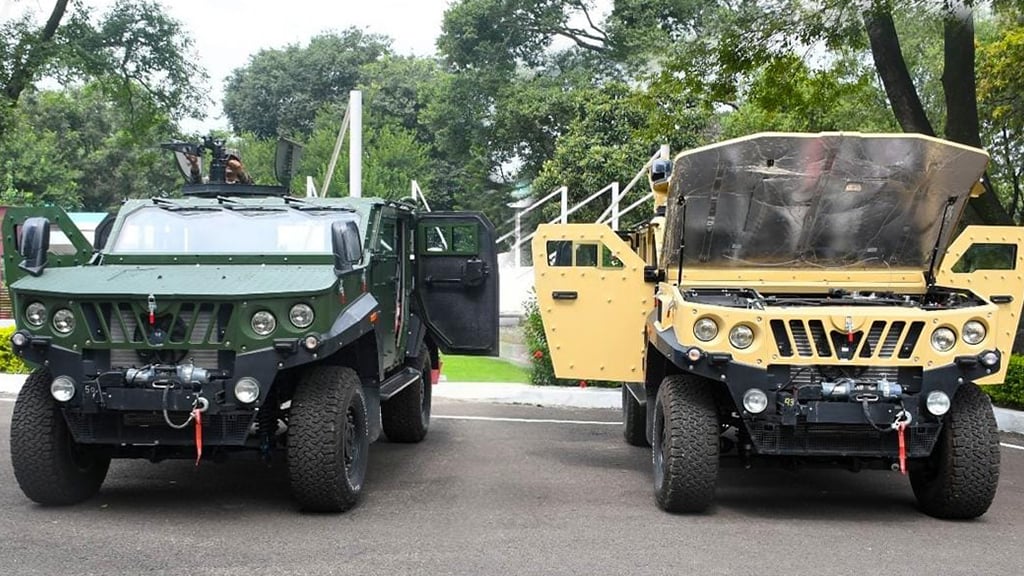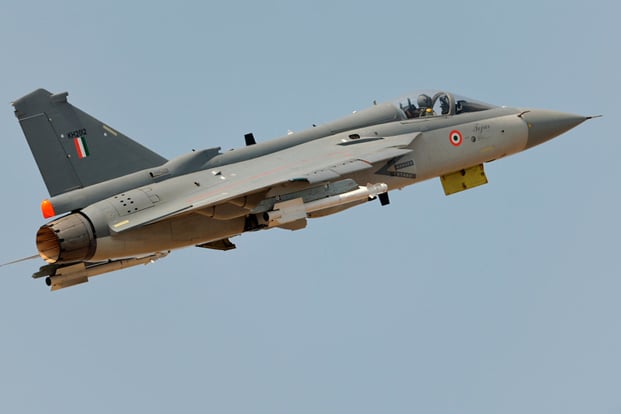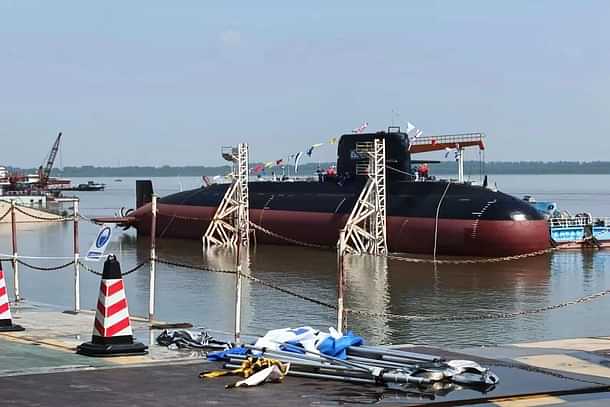AFI
SOURCE: AFI


In a decision that has defense enthusiasts buzzing with excitement, India has chosen ThyssenKrupp Marine Systems (TKMS) over Spain’s Navantia for its next-generation submarine procurement under Project 75-India (P75I). This choice marks a significant step forward in India’s naval capabilities, particularly in stealth technology and strategic maritime operations.
The submarine on offer from TKMS is described as a next-generation design, boasting a faceted hull that introduces Low Observable (LO) features. This design enhances the submarine’s stealth capabilities, making it the 5th generation of the diesel-electric attack submarine (SSK) with an emphasis on reducing its acoustic and radar signatures. The innovative hull shape is a radical departure from traditional designs, aiming to deflect sonar emissions, thereby making the submarine less detectable by modern anti-submarine warfare (ASW) systems.
Continue readingSOURCE: AFI


In a significant step forward for unmanned aerial vehicle technology, NewSpace Research and Technologies has unveiled a new type of long-endurance helicopter UAV. This innovative aircraft stands out with its streamlined design, featuring a tail rotor that enhances efficiency and stealth capabilities. The sleek, aerodynamic shape promises improved flight dynamics, making this UAV a potential game-changer in aerial surveillance and reconnaissance.
The helicopter UAV is not just about its unique design; it boasts a sophisticated tri-sensor gimbal camera system, which suggests capabilities for comprehensive day and night surveillance, thermal imaging, and high-resolution photography. This setup is ideal for various applications, including border security, disaster management, and military intelligence gathering, offering versatility in operational environments.
Continue readingSOURCE: AFI


In an exciting development for India’s aerospace sector, Prateek Dhawan, co-founder of DG Propulsion, has shared significant updates on the testing of their jet engines. The company, known for its pioneering work in propulsion technology, recently conducted a rigorous test where their engines operated in a vertical configuration for a full hour. This test not only included variable throttle adjustments to assess responsiveness but also maintained the engines at full throttle for the majority of the time.
Dhawan took to social media to share this milestone, although he noted with regret that the third video of this test session was not recorded. Despite this, the success of the test is a clear indicator of DG Propulsion’s advancements. “Jetsuits can absolutely be built in India now,” Dhawan confidently asserted, signaling a pivotal moment for the company and the Indian aerospace industry at large.
Continue readingSOURCE: AFI


The Indian Army’s affection for the Mahindra Armored Light Specialist Vehicle (ALSV) is no secret within defense circles, but the key to this admiration largely lies in the vehicle’s heart – a formidable 3.2-liter, 215 HP multi-fuel diesel engine sourced from Spanish technology. This engine, combined with a versatile 4/6 speed automatic transmission, has significantly enhanced the vehicle’s performance and adaptability on the battlefield.
The engine in question, a product of Spanish engineering excellence, offers a unique multi-fuel capability, allowing it to run on both NATO-grade diesel and other alternative fuels, ensuring operational flexibility in varied terrains and under diverse conditions. With a power output of 215 horsepower, the ALSV is designed to provide robust performance, whether it’s navigating through the rugged terrains of the Himalayas or the sandy stretches of the Thar Desert. The torque output, peaking at 500Nm, ensures that the vehicle can handle heavy loads and maintain mobility even in challenging conditions.
Continue readingSOURCE: AFI


The Indian Light Combat Aircraft (LCA) Tejas Mk1A has undergone significant aerodynamic enhancements aimed at reducing transonic drag and boosting acceleration capabilities. Key among these modifications are the redesign of the inboard pylon’s leading edge and the reshaping of the chin pylon for the Laser Designation Pod (LDP).
The leading edge of the inboard pylon on the Tejas Mk1A now features a slight backward taper. This design change is not merely cosmetic but is engineered to streamline airflow over the pylon at transonic speeds, where the air moves at or near the speed of sound. By reducing the drag in these speed regimes, the aircraft can achieve better acceleration and maintain higher velocities with less energy loss.
Continue readingSOURCE: AFI


In a significant diplomatic and strategic move, UK Deputy High Commissioner Chandru Iyer convened with Shri Jayakrishnan S, the CEO of the Bangalore Complex at Hindustan Aeronautics Limited (HAL), to reaffirm the commitment of the United Kingdom towards its longstanding partnership with one of India’s premier aerospace companies.
The meeting took place at the HAL Bangalore Complex, known for its pivotal role in India’s aerospace sector. The dialogue was centered on strengthening the ties between the UK and India, particularly in the areas of defense, aerospace technology, and industrial collaboration. This interaction highlights the importance both nations place on their mutual interests and shared history in aerospace development.
Continue readingSOURCE: AFI


As the countdown to Aero India 2025 begins, with the event set to take place from February 10 to 14 at the Air Force Station Yelahanka in Bengaluru, France has once again solidified its position as the premier exhibitor at Asia’s largest aerospace and defense exhibition. With a notable presence, France’s participation underscores its commitment to fostering aerospace innovation and collaboration on a global stage.
This year, France has outshined other nations by securing the top spot with an impressive lineup of 35 exhibitors. Key players in the French aerospace sector such as Dassault Aviation, Safran, and Thales have confirmed their participation. These companies are renowned for their cutting-edge technologies and solutions in aviation, defense, and space.
Continue readingSOURCE: AFI


DeepSeek, a burgeoning Chinese AI company known for its development of open-source large language models (LLM), has recently found itself at the centre of controversy in India due to its responses regarding the geopolitical sensitivities of the region. The AI’s handling of queries about Arunachal Pradesh and the northeastern states of India has raised questions about its neutrality and the influence of its Chinese origins on its data processing and response algorithms.
Indian users engaging with DeepSeek’s AI model observed peculiar responses when querying about Arunachal Pradesh and the broader northeastern region of India.
Continue readingSOURCE: AFI


In a notable reflection of his transactional approach to foreign relations, former US President Donald Trump publicly urged India to ramp up its procurement of US-made defense systems. His comments suggest that even the substantial defense contracts between India and the United States over the years, including the Rs 32,350 crore (approximately $3.9 billion) deal for 31 armed MQ-9B Predator drones finalized in October 2024, may not fully satisfy American expectations.
India has increasingly turned to the United States as a key defense supplier over the past decade and a half. Since 2007, Washington has secured over $25 billion worth of defense contracts with New Delhi, spanning a wide range of platforms and technologies. These deals underline the deepening strategic partnership between the two nations, driven by shared geopolitical interests, particularly in countering China’s growing influence in the Indo-Pacific region.
Continue readingSOURCE: AFI


In response to the ongoing shortfall of fighter jets within the Indian Air Force (IAF), the first squadron of the indigenous Light Combat Aircraft (LCA) Tejas Mk1, previously stationed at Sulur in Tamil Nadu, has been redeployed to a forward airbase in the western sector. This strategic move is aimed at enhancing the IAF’s interceptor capabilities, particularly along the border regions, following the integration of Beyond Visual Range (BVR) missile upgrades to the aircraft which were initially not part of the Initial Operational Clearance (IOC) configuration.
The relocation of the “Flying Daggers” squadron underscores the IAF’s commitment to bolstering its air defence capabilities in a region where tensions necessitate a strong aerial presence. The Tejas Mk1, with its new BVR capabilities, can now engage targets at extended ranges, significantly increasing the effectiveness of air operations in this critical area.
Continue readingSOURCE: AFI


NewSpace Research and Technologies, a trailblazer in India’s aerospace sector, has recently showcased a groundbreaking new type of loitering munition that promises to redefine tactical aerial capabilities. The design of this new munition features a distinctive cropped delta-wing configuration, with the central fuselage seamlessly integrating into the wings. Stabilizing rudders at the wingtips add to the aerodynamic profile, while an autonomous pusher-propeller system is set to provide both stealth and efficiency in flight.
The loitering munition’s design aesthetics and engineering suggest it is tailored for long-range operations. Analysts and enthusiasts alike are speculating that this drone could achieve a range between 300 to 500 kilometers, offering significant strategic advantages in surveillance, reconnaissance, and precision strike missions. This capability would mark a notable advancement in the field of unmanned aerial systems, especially given its potential for slow, prolonged loitering over areas of interest.
Continue readingSOURCE: AFI


Recent images released on Chinese social media platform Weibo have provided a fascinating glimpse into the evolving design of China’s J-XDS, a sixth-generation fighter jet. This development represents a significant leap in China’s pursuit of cutting-edge aviation technology and air dominance. The innovative design features of the J-XDS indicate an emphasis on stealth, agility, and advanced combat capabilities, marking a major milestone in the People’s Liberation Army Air Force’s (PLAAF) modernization efforts.
One of the standout features of the J-XDS is its full-moving wingtips, a departure from traditional fighter aircraft designs. This unique aerodynamic feature is likely aimed at maximizing the fighter’s maneuverability during high-speed and complex flight operations.
Continue readingSOURCE: AFI


In a recent statement that has stirred significant controversy and public debate, Sam Pitroda, Chairman of the Indian Overseas Congress, suggested that India should accommodate illegal immigrants, advocating for a policy where Indians “share” resources, even at the cost of some “suffering.” This suggestion has not only ignited a political firestorm but has also led to calls for accountability, particularly from those who see it as an overreach by a non-Indian citizen into India’s domestic affairs.
Pitroda’s remarks were made in the context of discussing immigration policies, where he argued for a more inclusive approach towards illegal immigrants in India. His comments implied that the Indian population should be prepared to share their resources and endure any resultant hardships. This perspective has been met with backlash, especially given India’s already strained infrastructure and resources.
Continue readingSOURCE: AFI


In a recent interview with SUNO News HD, Commodore (R) Syed Muhammad Obaidullah of the Pakistan Navy made bold claims regarding the superiority of the Chinese-supplied Hangor-class submarines over the French-designed Scorpène-class submarines operated by the Indian Navy. According to Obaidullah, the edge lies in the Chinese Air Independent Propulsion (AIP) system.
However, this narrative requires a deeper examination of the technology at play. The Hangor-class submarines, an export variant of China’s Type 039A Yuan-class, are indeed equipped with AIP, but the specifics of this technology merit scrutiny.
Continue readingSOURCE: AFI


In a significant development for underwater warfare, Thyssenkrupp Marine Systems (TKMS) and Diehl Defence are set to redefine submarine self-defense with their Interactive Defense and Attack System (IDAS). This innovative system, which allows submarines to engage aerial threats while submerged, has caught the attention of several countries, including India, which is poised to leverage this technology in its naval expansion plans.
Traditionally, submarines have been vulnerable to aerial threats like ASW helicopters equipped with dipping sonar and lightweight torpedoes. IDAS breaks this paradigm by enabling submarines to counter these threats without breaking the water’s surface, thus maintaining stealth.
Continue reading